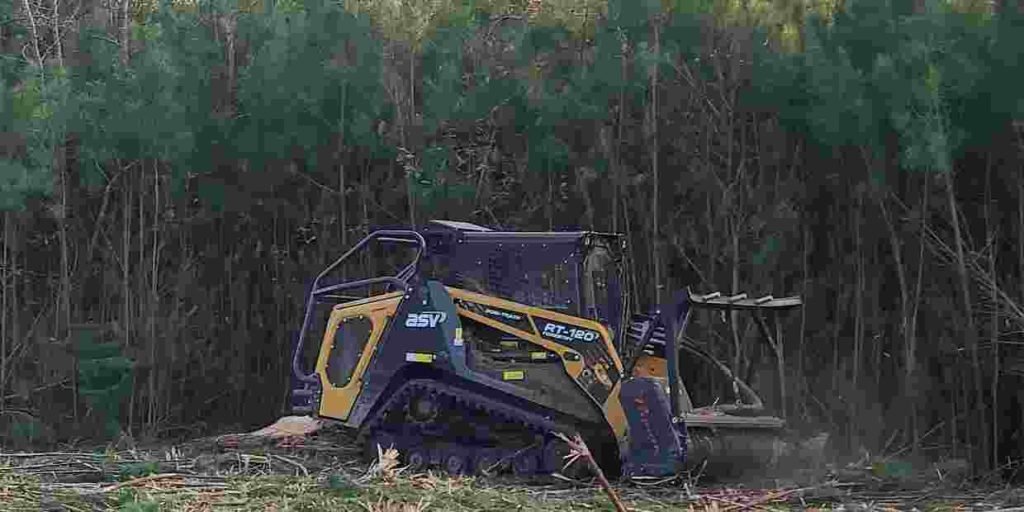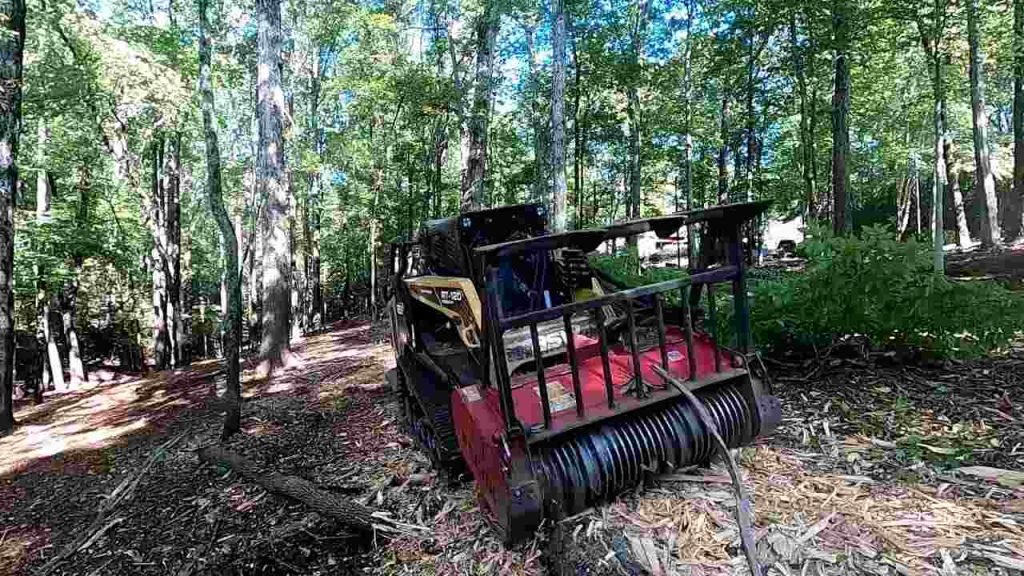Forestry mulching is a highly effective land clearing method that can be suitable for steep terrain under the right conditions. Unlike traditional methods that may cause erosion and disrupt the natural landscape, forestry mulching involves using specialized equipment to grind vegetation into mulch, leaving the soil undisturbed. This process helps to control erosion, retain soil nutrients, and promote regrowth of native vegetation. In steep terrain, forestry mulching can be particularly beneficial as it minimizes the risk of soil erosion and reduces the need for extensive grading and excavation. On this journey, Rightway Forestry helps to discover the suitability of forestry mulching in steep areas depends on factors like slope gradient, soil stability, and site accessibility.
Equipment Capability
Forestry mulching in steep terrain hinges significantly on the capabilities of specialized equipment. These machines are purpose-built to handle rugged landscapes, offering features like enhanced traction, stability, and maneuverability. Track-mounted mulchers, for instance, excel in navigating steep slopes by distributing weight evenly and minimizing slippage. Similarly, mulching machines with specialized tires designed for off-road use provide increased grip and control on uneven surfaces.
Advanced equipment also includes safety features such as roll-over protection structures (ROPS) and operator cabins with ergonomic designs for comfort and control. These features are crucial for ensuring operator safety, especially in challenging terrain where stability and control are paramount. Moreover, modern mulching equipment often incorporates technology such as GPS systems and remote monitoring capabilities, enhancing operational efficiency and precision.
Terrain Assessment
Before commencing mulching operations in steep terrain, a thorough terrain assessment is imperative. This assessment encompasses detailed surveys to determine slope gradients, soil types, drainage patterns, presence of obstacles like boulders or stumps, and potential erosion hotspots. LiDAR (Light Detection and Ranging) technology, aerial surveys, and ground reconnaissance aid in gathering precise data for informed decision-making.
Understanding soil stability and erosion risks guides the planning and execution of mulching activities. Steeper slopes may require specialized techniques such as contour mulching to minimize soil disturbance and prevent erosion. Identification of sensitive areas like waterways or wildlife habitats allows for strategic planning to minimize environmental impacts.
Erosion Control
Erosion control is paramount in steep terrain to prevent soil loss, sedimentation, and downstream water quality degradation. Mulching operations can disturb soil structure, making erosion control measures essential. Techniques such as installing erosion control blankets, mulch berms, and vegetative buffers help stabilize slopes, reduce runoff velocities, and promote infiltration.
Incorporating erosion-resistant vegetation into mulching plans enhances slope stability and erosion control efforts. Native grasses, shrubs, and trees with deep root systems are particularly effective in anchoring soil and preventing erosion. Moreover, sediment traps and check dams strategically placed along contours can intercept sediment-laden runoff, protecting water bodies downstream.
Selective Clearing
Selective land clearing plays a vital role in maintaining ecological balance and minimizing habitat disruption in steep terrain. Rather than clear-cutting, selective mulching targets specific vegetation while leaving desirable species intact. This approach preserves critical habitat elements, minimizes soil disturbance, and promotes biodiversity.
Selective mulching techniques include crown thinning to remove excess vegetation, targeted removal of invasive species, and creating wildlife corridors within the landscape. These practices support ecosystem resilience, maintain habitat connectivity, and enhance wildlife diversity. Collaborating with ecologists and wildlife experts ensures that selective clearing aligns with conservation goals while meeting land management objectives.

Expertise and Experience
Successful forestry mulching in steep terrain relies on the expertise and experience of skilled professionals. Experienced operators possess in-depth knowledge of equipment capabilities, terrain dynamics, and environmental considerations. They undergo specialized training in safe operating practices, terrain assessment, erosion control techniques, and habitat preservation strategies.
Expertise extends to regulatory compliance, permitting requirements, and stakeholder engagement. Effective communication and collaboration with landowners, regulatory agencies, and conservation organizations are essential for project success. Experienced teams prioritize safety, environmental stewardship, and achieving project objectives efficiently.
Environmental Sustainability
Environmental sustainability is a core principle in forestry mulching, especially in steep terrain. Sustainable practices focus on minimizing ecological impacts, preserving natural resources, and fostering ecosystem health. Mulching operations integrate best management practices such as minimizing soil compaction, avoiding sensitive habitats, and promoting revegetation.
Efforts to reduce carbon footprint, recycle mulch materials, and implement erosion control measures contribute to environmental sustainability. Monitoring and adaptive management techniques ensure that mulching practices align with long-term conservation goals. By prioritizing environmental sustainability, mulching projects become integral components of sustainable land management practices.
Soil Health and Nutrient Retention
Forestry mulching has implications for soil health and nutrient cycling, especially in steep terrain. Soil compaction, a common concern during mulching operations, can affect water infiltration, root growth, and nutrient availability. To mitigate compaction, mulching equipment with low ground pressure and specialized tracks or tires is employed. This minimizes soil disturbance while allowing for effective vegetation removal.
Mulch itself plays a crucial role in nutrient retention. As organic matter decomposes, nutrients like nitrogen, phosphorus, and potassium are released into the soil. Mulch acts as a natural fertilizer, enriching the soil and supporting regrowth of vegetation. Soil testing before and after mulching helps assess nutrient levels and guides any necessary amendments to maintain soil fertility.
Wildlife Habitat Enhancement
Selective mulching strategies are employed to enhance wildlife habitat diversity in steep terrain. Preservation of key habitat features such as snags, fallen logs, and native vegetation patches fosters biodiversity. Mulched areas can create valuable wildlife openings, promoting habitat for species like deer, small mammals, and ground-nesting birds.
Additionally, edge habitats created by mulching interfaces between different vegetation types, supporting species that thrive in transitional zones. Careful consideration of wildlife corridors and connectivity ensures that mulching activities contribute positively to overall habitat functionality and species diversity.

Water Quality Protection
Protecting water quality is paramount during forestry mulching operations. Sediment runoff from steep terrain can degrade water bodies and aquatic habitats. Best management practices (BMPs) are implemented to minimize erosion and sedimentation. These may include erosion control blankets, silt fences, and vegetative buffers along waterways.
Mulching operations steer clear of sensitive riparian zones and wetlands to prevent direct impacts on water quality. Sediment traps and retention ponds are strategically placed to capture runoff and filter sediment before it enters water bodies. Regular monitoring of water quality parameters ensures compliance with regulatory standards and environmental protection goals.
Community Engagement and Stakeholder Involvement
Community engagement and stakeholder involvement are integral to the success of forestry mulching projects in steep terrain. Public outreach programs, stakeholder meetings, and educational initiatives inform local communities about project objectives, environmental benefits, and mitigation measures. Engaging stakeholders early in the planning process fosters collaboration, transparency, and mutual understanding of land management priorities.
Consulting with indigenous communities, landowners, conservation groups, and regulatory agencies ensures that mulching activities align with local values, cultural practices, and environmental regulations. Feedback from stakeholders informs decision-making and helps address concerns or preferences related to project implementation.
Monitoring and Adaptive Management
Continuous monitoring and adaptive management are critical components of effective land management in steep terrain. Monitoring programs track changes in soil erosion, vegetation regrowth, wildlife populations, and water quality indicators. This data informs adaptive management strategies, allowing project teams to adjust mulching practices in response to observed impacts or changing environmental conditions.
Adaptive management includes modifying mulching techniques, implementing additional erosion control measures, or revising project timelines based on monitoring results. Regular site inspections, data collection, and stakeholder feedback facilitate adaptive decision-making and promote sustainability throughout the project lifecycle.
Long-Term Sustainability and Legacy Planning
Long-term sustainability and legacy planning ensure that the benefits of forestry mulching endure beyond the project’s completion. Post-mulching plans include revegetation efforts, invasive species control, habitat restoration, and ongoing maintenance. Restoring native vegetation helps stabilize slopes, prevent erosion, and enhance ecosystem resilience.
Legacy planning involves documenting project outcomes, lessons learned, and best practices for future reference. It also considers the potential for adaptive reuse of mulched areas, such as reforestation projects or wildlife habitat enhancements. By integrating long-term sustainability measures and legacy planning into mulching projects, land managers contribute to landscape conservation and environmental stewardship for future generations.
Conclusion:
In conclusion, forestry mulching can be a suitable and effective land clearing method for steep terrain, provided that the specific conditions of the site are taken into consideration. Its ability to minimize soil erosion, retain soil nutrients, and promote regrowth makes it an environmentally friendly option for land management in challenging landscapes. However, it’s important to assess factors such as slope gradient, soil stability, and site accessibility before deciding on the suitability of forestry mulching for a particular area. Consulting with experienced professionals and conducting a thorough site evaluation can help determine the best approach to land clearing and conservation in steep terrain.

